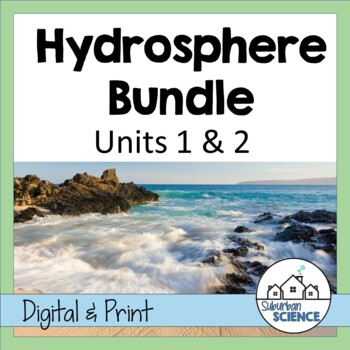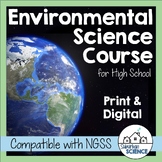Hydrosphere Bundle- Water Cycle, Groundwater, Marine Biomes, Water Pollution
- Zip
What educators are saying
Products in this Bundle (2)
Also included in
- These environmental lesson plans will help your students to take charge of their learning! This comprehensive course is interactive, hands-on, and student-centered! Students learn about major environmental issues in modern society through detailed lessons and activities. Units cover the four sphePrice $250.00Original Price $276.00Save $26.00
Description
This bundle contains 6 weeks' worth of lessons, labs, and field activities to introduce your high school students to aquatic ecosystems, surface water, groundwater, marine biomes, and water pollution. Choices are integrated into the unit to provide options for teaching and learning in a variety of ways: lecture and notes, web-quests, and projects. The independent options are ideal for sub plans while activities and extension pages provide opportunities for class discussion and critical thinking. Human impacts on the environment are interwoven through each lesson to provide students with a good basis for any environmental science or APES course.
All student pages come in both PRINT and DIGITAL versions for efficient use in class or through distance learning.
**PLEASE NOTE: This bundle is also part of my FULL ENVIRONMENTAL SCIENCE COURSE.**
➤Included in this product:
-Detailed Teacher Planning Pages (standards document, editable daily pacing guide, differentiation ideas for student interest, ability, and learning environment)
-3 PowerPoints (92 colorful, animated slides)
-8 pages of Cornell Notes (both fill-in-the-blank and editable versions)
-5 web-quests with corresponding student questions
-5 pages of my popular Doodle Notes (TM)
-14 activities (projects, research, outdoor explorations, and group activities)
-16 extension pages focusing on critical thinking skills and math integration
-2 online quizzes through Google Forms
-48 editable task cards for a quick and easy unit review
-2 editable unit tests with multiple-choice and short answer questions (in both honors and regular versions)
-Supplementary Resource Ideas: links and videos for additional explanation or exploration
-Answer keys and grading rubrics for all student pages
➤What topics are included in this unit?
Introduction to Water & The Hydrologic Cycle
- Unique properties of water
- Cohesion v. adhesion
- Processes in the water cycle (transpiration, condensation, evaporation, etc.)
- Acid rain
- Effects of deforestation on the water cycle
Surface Water & Watersheds
- Watersheds (tributaries, divides, etc.)
- Headwaters v. flat river
- Estuaries
- Eutrophication and acidification of aquatic ecosystems
- Macroinvertebrate identification
- Structure and impact of dams
- Benefits of riparian buffers
Groundwater & Irrigation
- Water table
- Aquifers (confined v. unconfined)
- Tragedy of the Commons
- Types of irrigation (flood, furrow, spray, drip)
- Human impacts from groundwater usage (depletion of aquifers, salinization, etc)
- Types of aquatic biomes (saltwater, freshwater, estuaries)
- Adaptations for the intertidal zone
- Ocean productivity and nutrients in ocean food webs
- Ocean zones (euphotic, disphotic, aphotic)
- Light penetration in ocean
- Oil spills and clean-up methods
- Aquaculture v. Fishing, maximum sustainable yield
- Coral bleaching
Wetlands & Water Pollution
- Water Quality
- Point-source v. nonpoint-source pollution
- Microplastic pollution
- Oxygen sag curve and nutrient pollution
- Effects of pollution on aquatic ecosystems (thermal pollution, sediment pollution, nutrient pollution, chemical pollution, biological pollution)
- Persistent Organic Pollutants (POPs)
- Bioaccumulation v. biomagnification
- Bioassays and LD50
- Characteristics of wetlands
- Environmental benefits of wetlands
The unit is aligned to NGSS and many state standards. If you’d like to know whether your state standards are covered, you can send me an email at support@suburbanscience.com. Additional details on standards are included in the teacher planning pages of this course.
________________________________________________________________________
*For more details about the specific topics and items included, please see the PREVIEW for each lesson.*
________________________________________________________________________
➤No textbook? No problem!
These units are designed to coordinate with topics found in most Environmental Science textbooks and some Biology & Earth Science books, as well. Because of the wealth of material, however, the units can be stand-alone and used without a textbook at all. Teacher pacing guides and instructions are included to help you organize the content in a logical way.
➤New to teaching Environmental Science? Here’s how this unit will save you time:
1) The included NGSS, state standards, pacing guides, and differentiation ideas make lesson planning a breeze.
2) Multiple options for content delivery are included for built-in differentiation. Use web-quests for independent or 1:1 classes or use the PowerPoints and guided notes for classes that need more structure.
3) Student pages are compiled into one document that’s ready to print and copy all at once!
4) The PowerPoints coincide perfectly with the Cornell Notes pages, making lectures easy. The PowerPoints even have bolded terms that match the fill-in-the-blank Cornell Notes for error-proof student notes!
5) Teaching instructions, material lists, answer keys, student examples, and photos are all included so you’ll know exactly how to plan for and explain each activity to your students.
6) Editable PowerPoints, Cornell Notes, and assessments make it quick and easy for you to add or remove content to fit your standards and the needs of your class.
What curriculum could I use with these lessons?
This lesson is ideally geared towards high school students and would work well with a general level Environmental Science or Biology textbook. It addresses the following topics in AP Environmental Science (APES):
- 1.3: Aquatic Biomes
- 1.7: The Hydrologic (Water) Cycle
- 1.8: Primary Productivity
- 1.10: Trophic Levels
- 4.6: Watersheds
- 5.1: The Tragedy of the Commons
- 5.5: Irrigation Methods
- 5.8: Impacts of Overfishing
- 5.9: Impacts of Mining
- 5.10: Impacts of Urbanization
- 5.12: Introduction to Sustainability
- 5.16: Aquaculture
- 8.1: Sources of Pollution
- 8.2: Human Impacts on Ecosystems
- 8.3: Endocrine Disruptors
- 8.4: Human Impacts on Wetlands and Mangroves
- 8.5: Eutrophication
- 8.6: Thermal Pollution
- 8.7: Persistent Organic Pollutants
- 8.8: Bioaccumulation and Biomagnification
- 8.11: Sewage Treatment
- 8.12: Lethal Does 50% (LD50)
- 8.14: Pollution and Human Health
- 9.5: Global Climate Change
- 9.6: Ocean Warming
- 9.7: Ocean Acidification
➤Teaching virtual students this year?
All student pages and presentations included in this unit are available in PRINT or DIGITAL through Google Slides™ to be completed at home or in a 1:1 classroom. Students can view the PowerPoint or web-quests at home, type on the pages, and even use Doodle Notes™! These digital pages work for any learning platform in which students can access Google Slides™ (Google Classroom™, Microsoft OneDrive™, Canvas™, etc). If you’re not sure whether the digital version will work for your students, just send me an email at support@suburbanscience.com and I can give you a free sample to test.
I have taught Environmental Science both in classroom settings and through homeschool courses. Although this course was not designed specifically for individual homeschool use, the materials and resources included can be easily found at home and/or completed in a virtual or homeschool setting.
➤Can I edit these resources to fit my needs?
Some of the files in this unit are editable. The text on the PowerPoints, Cornell Notes, and task cards is all editable so you can adjust the level of content and wording. The pacing guide, printable unit tests, and online quizzes through Google Forms™ are all fully editable. Web-quests, activities, extension pages, and any images included in this unit are in non-editable PDF formats to protect my intellectual property rights and those of the illustrators whose images I’ve purchased for use in this resource.
⭐For updates about sales and new products, please follow my store: My TpT Store
You can also
⭐Subscribe to my newsletter for freebies and teaching tips
⭐Follow me on Instagram
⭐Check out my Facebook page
⭐Follow me on Pinterest
I value your feedback. Please rate this product. If you have any issues or questions about this product, please feel free to ask a question in my store or write to me at support@suburbanscience.com.






